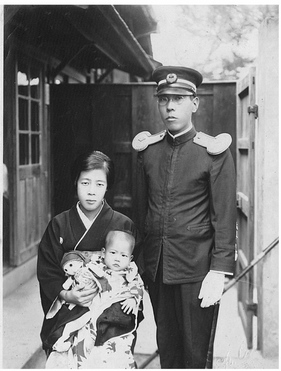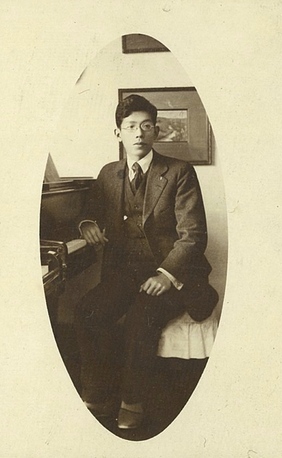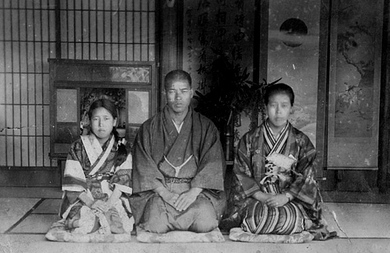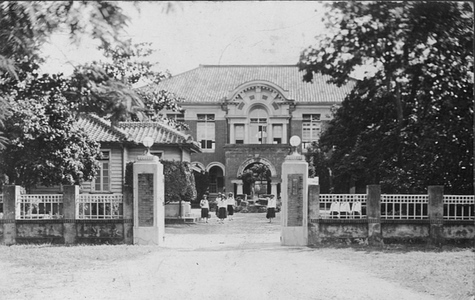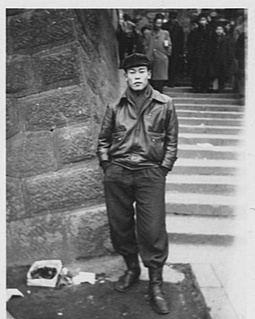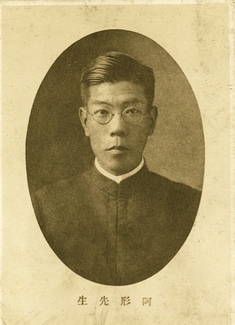 Agata Sensei (Prof. Agata)
Read from right to left
Agata Sensei (Prof. Agata)
Read from right to left
I would like to introduce my grandfather in honor of his lifetime achievement. He was only 38 when he passed but his legacy as a music teacher in early 1900s Japan deserves attention however short his life and his musical career was. I believe he inspired many and helped build the foundation of the music education in Japan today.
In 1900, my grandfather, Shōkichi Agata was born in Tokyo. He was educated under the old Japanese education system that started in 1872 until the School Education Law* was enacted in 1947 and exists to this day. (*Determined as part of the democratization policy under the occupational administration, General Headquarters, the Supreme Commander for the Allied Powers, known as GHQ)
After receiving higher education beyond compulsory education, he studied at Aoyama Shihan Gakkō in Tokyo, (shihan means teacher or master) a school that trains students to become schoolteachers, after which he went on to study music, majoring in music education at Tokyo Ongaku Gakkō, Tokyo school of music in order to become a music teacher. He graduated in 1926 and started his career as a music teacher.
Tokyo Ongaku Gakko, Tokyo School of Music was established by the imperial government in 1887 and was the first and only professional music school in Japan with a focus on Western music. The school later became the foundation for the Tokyo University of the Arts (Tokyo Geijutsu Daigaku or commonly called Tokyo Geidai), which was established as a result of the School Education Law in postwar 1949. The school continues to maintain its prestige to this day as the first music school with its history and tradition.
Though I never got to know my grandfather because of his premature death at the age of 38 in 1938, I grew up hearing about him from my grandmother who lived with us until her passing at the age of 86. My grandmother, Kesayo who was born in 1909 in Yamanashi-prefecture and met my grandfather, Shōkichi, when she was going to school at Yamanashi Kōtō Jogakkō (Yamanashi higher women’s school) where Shōkichi was a music teacher there. During her lifetime, she was proud to have received higher education when very few people were able to during that period.
After she graduated from school, she soon married to Shōkichi who was about to transferred to Tainan, Taiwan, which was a Japanese territory at that time. Teachers in those days were employees of the imperial government and they were routinely transferred from place to place. They were in Taiwan for 6 years and had 4 children before they were moved to Miyazaki-prefecture to teach at Miyazaki Shihan Gakkō (Miyazaki teaching school now exists as Miyazaki University) in 1934. My father was one of the children born in Taiwan.
Shōkichi studied piano and composition with Ryutaro Hirota while he was at Tokyo school of music. Ryutaro Hirota is well known in Japan as a composer who left us a number of compositions, especially children’s song that are still sung today. Ryutaro Hirota was also a graduate from Tokyo School of Music and taught there after graduation. He later studied piano and composition in Berlin, Germany.
I heard from my grandmother that Shōkichi composed music and contributed his compositions to schools. One of his compositions is still sung today at Nobeoka elementary school as its school song in Miyazaki-prefecture. After the death of Shōkichi in Miyazaki in 1938, my grandmother kept in touch with Professor Hirota. Postwar when my father was attending Koishikawa Kogyo high school in Shinjuku, Tokyo where he studied to become an architect, he visited the home of Professor Hirota and asked him to compose cheer song for his high school baseball team to which he readily agreed. Now that Koishikawa Kogyo high school is consolidated with another school, my father wonders if the cheer song still exists.
When my father was going to school during and after World War II, he witnessed the bombing and incineration of Tokyo from the hills surrounding the city. After the war, he recalled how difficult and uncertain life was. Even though they had the money, there was nothing there to buy. Sometimes he rode packed trains for hours for his mother and younger siblings to get some vegetables. In memory of her husband, my grandmother kept all Shōkichi’s music and text books, but in those hard days my father took all the books to a secondhand book store in Jimbō-cho, Kanda, Tokyo to get some money. He said he made a small fortune from those books because of their high value and rarity. Jimbō-cho town is still famous for its large number of bookstores it has. I wish the books were kept in the family just so I could satisfy my curiosity as to what my grandfather studied and what was taught back in those days.
My grandmother told me how Shōkichi loved children and how he would have taught me piano while I was taking piano lessons in my childhood years. Shōkichi remained her love of her life. Though she lost him so young, she never remarried and raised her children as a single mother as a seamstress and on Shōkichi’s pension. I heard that my grandmother’s father supported her also. During her lifetime, my grandmother never got over her misfortune of losing her mother when she was 17, her husband when she was 29 leaving her with 5 children, and losing her 8-year old daughter, Kyoko, who was born in Miyazaki.
As a little girl, I spent a lot of time with my grandmother. It is still a Japanese custom, though it is not supported as much now a days, that the first born son takes care of his mother. She was always there to help and comfort me and my two other siblings. We were everything to her. As a child, I could not understand what every thing meant to her when she told me her life story. Now I have a little more life experience and have my own family, I understand how difficult her life had been. I hope she reunited with her husband and finally are living happily ever after.
In 1900, my grandfather, Shōkichi Agata was born in Tokyo. He was educated under the old Japanese education system that started in 1872 until the School Education Law* was enacted in 1947 and exists to this day. (*Determined as part of the democratization policy under the occupational administration, General Headquarters, the Supreme Commander for the Allied Powers, known as GHQ)
After receiving higher education beyond compulsory education, he studied at Aoyama Shihan Gakkō in Tokyo, (shihan means teacher or master) a school that trains students to become schoolteachers, after which he went on to study music, majoring in music education at Tokyo Ongaku Gakkō, Tokyo school of music in order to become a music teacher. He graduated in 1926 and started his career as a music teacher.
Tokyo Ongaku Gakko, Tokyo School of Music was established by the imperial government in 1887 and was the first and only professional music school in Japan with a focus on Western music. The school later became the foundation for the Tokyo University of the Arts (Tokyo Geijutsu Daigaku or commonly called Tokyo Geidai), which was established as a result of the School Education Law in postwar 1949. The school continues to maintain its prestige to this day as the first music school with its history and tradition.
Though I never got to know my grandfather because of his premature death at the age of 38 in 1938, I grew up hearing about him from my grandmother who lived with us until her passing at the age of 86. My grandmother, Kesayo who was born in 1909 in Yamanashi-prefecture and met my grandfather, Shōkichi, when she was going to school at Yamanashi Kōtō Jogakkō (Yamanashi higher women’s school) where Shōkichi was a music teacher there. During her lifetime, she was proud to have received higher education when very few people were able to during that period.
After she graduated from school, she soon married to Shōkichi who was about to transferred to Tainan, Taiwan, which was a Japanese territory at that time. Teachers in those days were employees of the imperial government and they were routinely transferred from place to place. They were in Taiwan for 6 years and had 4 children before they were moved to Miyazaki-prefecture to teach at Miyazaki Shihan Gakkō (Miyazaki teaching school now exists as Miyazaki University) in 1934. My father was one of the children born in Taiwan.
Shōkichi studied piano and composition with Ryutaro Hirota while he was at Tokyo school of music. Ryutaro Hirota is well known in Japan as a composer who left us a number of compositions, especially children’s song that are still sung today. Ryutaro Hirota was also a graduate from Tokyo School of Music and taught there after graduation. He later studied piano and composition in Berlin, Germany.
I heard from my grandmother that Shōkichi composed music and contributed his compositions to schools. One of his compositions is still sung today at Nobeoka elementary school as its school song in Miyazaki-prefecture. After the death of Shōkichi in Miyazaki in 1938, my grandmother kept in touch with Professor Hirota. Postwar when my father was attending Koishikawa Kogyo high school in Shinjuku, Tokyo where he studied to become an architect, he visited the home of Professor Hirota and asked him to compose cheer song for his high school baseball team to which he readily agreed. Now that Koishikawa Kogyo high school is consolidated with another school, my father wonders if the cheer song still exists.
When my father was going to school during and after World War II, he witnessed the bombing and incineration of Tokyo from the hills surrounding the city. After the war, he recalled how difficult and uncertain life was. Even though they had the money, there was nothing there to buy. Sometimes he rode packed trains for hours for his mother and younger siblings to get some vegetables. In memory of her husband, my grandmother kept all Shōkichi’s music and text books, but in those hard days my father took all the books to a secondhand book store in Jimbō-cho, Kanda, Tokyo to get some money. He said he made a small fortune from those books because of their high value and rarity. Jimbō-cho town is still famous for its large number of bookstores it has. I wish the books were kept in the family just so I could satisfy my curiosity as to what my grandfather studied and what was taught back in those days.
My grandmother told me how Shōkichi loved children and how he would have taught me piano while I was taking piano lessons in my childhood years. Shōkichi remained her love of her life. Though she lost him so young, she never remarried and raised her children as a single mother as a seamstress and on Shōkichi’s pension. I heard that my grandmother’s father supported her also. During her lifetime, my grandmother never got over her misfortune of losing her mother when she was 17, her husband when she was 29 leaving her with 5 children, and losing her 8-year old daughter, Kyoko, who was born in Miyazaki.
As a little girl, I spent a lot of time with my grandmother. It is still a Japanese custom, though it is not supported as much now a days, that the first born son takes care of his mother. She was always there to help and comfort me and my two other siblings. We were everything to her. As a child, I could not understand what every thing meant to her when she told me her life story. Now I have a little more life experience and have my own family, I understand how difficult her life had been. I hope she reunited with her husband and finally are living happily ever after.
